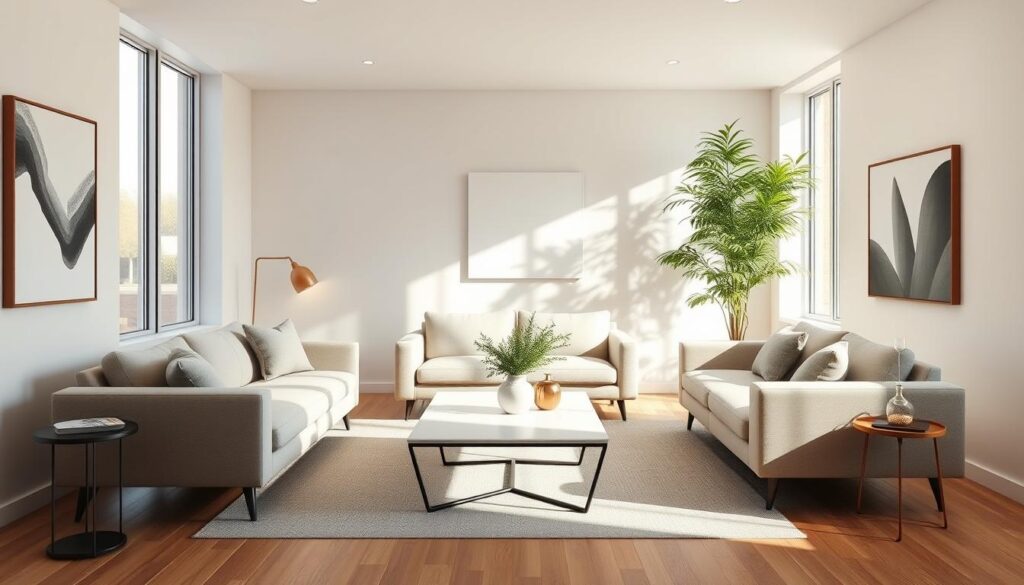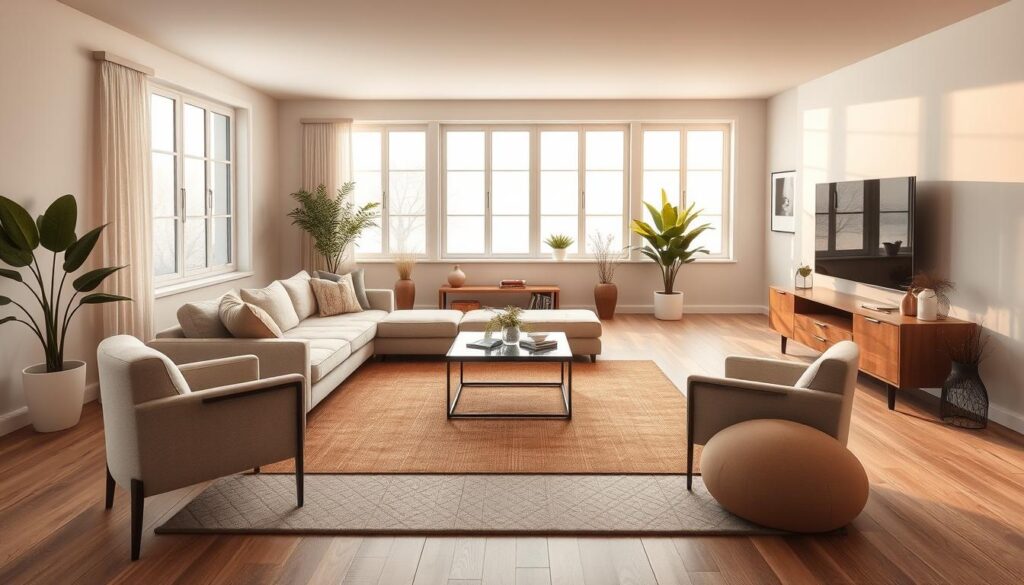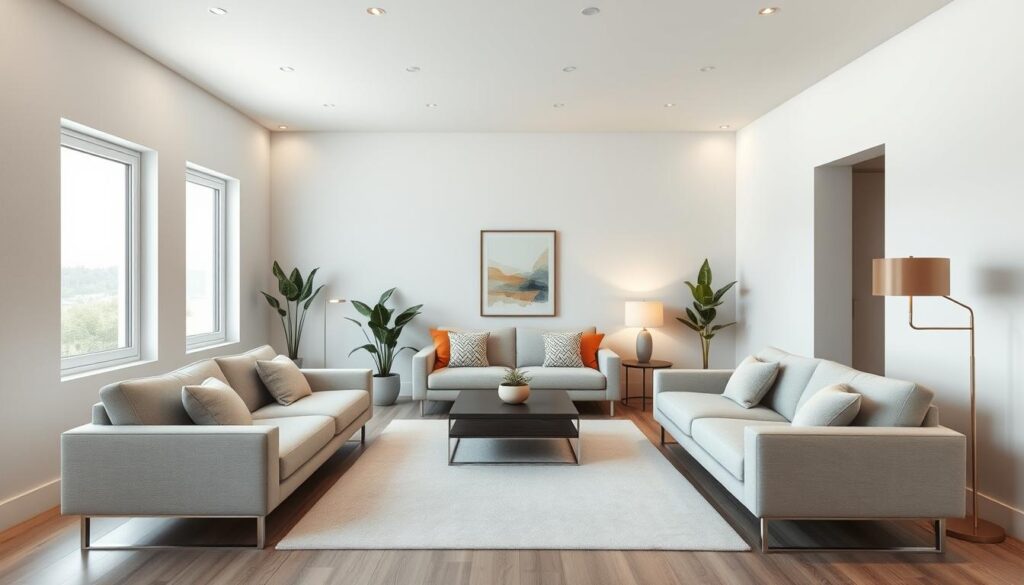Are you struggling to make the most of your Rectangular Living Room Designs? You’re not alone. Many homeowners face the challenge of turning a long, narrow space into a cozy and functional area. The good news is that with the right design strategies, you can transform your tight living space into a beautiful and inviting room.

Whether you’re looking to create a comfortable seating area, optimize the use of space, or simply make your room feel larger, this article will provide you with practical solutions and inspiration. We’ll explore various design approaches to help you maximize your room’s potential.
Key Takeaways
- Discover how to create a functional layout in a rectangular living room.
- Learn tips for optimizing the use of space in tight areas.
- Explore design strategies to make your room feel larger and more inviting.
- Find out how to create a cozy and comfortable seating area.
- Get inspiration for turning your rectangular living room into a beautiful space.
Understanding the Challenges of Rectangular Living Rooms
While Rectangular Living Room Designs offer ample space, they also present distinct layout challenges. The elongated shape can make it difficult to create a cohesive atmosphere, often resulting in an awkward traffic flow.
Common Layout Problems
One of the primary issues with rectangular living rooms is the tendency to create a “hallway” effect, where the room feels more like a corridor than a living space. This can be mitigated by centering your key pieces, such as the sofa, to create a focal point.
The Potential of Rectangular Spaces
Despite the challenges, rectangular living rooms have significant potential. Their length can be leveraged to create distinct zones within the room, such as a seating area and a reading nook, enhancing the room’s functionality.

Identifying Your Room’s Proportions
To effectively design a rectangular living room, it’s crucial to understand its proportions. Measure the room’s length, width, and any architectural features that could impact the layout. This will help in planning a space that is both aesthetically pleasing and functional.
By understanding the challenges and potential of your rectangular living room, you can begin to envision a space that is optimized for comfort and style.
Assessing Your Space: Measurements and Planning
Before you start rearranging your furniture, it’s crucial to understand the dimensions and layout of your rectangular living room. Accurate measurements and a well-thought-out plan are essential for creating a space that is both functional and aesthetically pleasing.
Taking Proper Measurements
To start, take precise measurements of your room’s length, width, and any architectural features such as alcoves, doorways, or windows. Record these measurements carefully to reference later when planning your furniture arrangement.
Creating a Floor Plan
Using your measurements, create a basic floor plan. This can be done using graph paper or online room planning tools. A floor plan helps visualize the space and identify potential furniture layouts. Consider using space-saving furniture to maximize your room’s functionality.

Identifying Traffic Flow Patterns
Observe how people move through the room. Identifying traffic flow patterns helps in arranging furniture in a way that doesn’t obstruct movement. Leave enough space between furniture pieces for comfortable navigation.
Working with Architectural Features
Take note of any architectural features that could impact your furniture arrangement, such as heating vents, electrical outlets, or built-in shelving. Working with these features rather than against them can enhance the overall functionality of your space.
| Measurement | Dimension | Notes |
|---|---|---|
| Room Length | 15 feet | |
| Room Width | 10 feet | |
| Doorway Width | 3 feet | Consider a slim console table |
By carefully assessing your space and planning your furniture arrangement, you can create a rectangular living room that is both beautiful and functional. Using space-saving furniture is a key strategy in making the most of your room’s dimensions.
Furniture Arrangement Strategies for Rectangular Living Room Designs
Rectangular living rooms present a unique challenge when it comes to furniture arrangement, but with the right strategies, they can be transformed into stunning spaces. The key to a successful layout lies in understanding how to work with the room’s dimensions to create a functional and aesthetically pleasing environment.
Centering Your Key Pieces
One effective strategy is to center your key pieces, such as a sofa or a fireplace, to create a focal point in the room. This helps to anchor the space and provides a sense of balance. When choosing a central piece, consider its scale and proportion relative to the room.
Creating Conversation Areas
Creating conversation areas is crucial for making a rectangular living room feel cozy and inviting. Arrange furniture in a way that encourages interaction, such as placing chairs and sofas in a circular configuration. This not only fosters conversation but also helps to define the space.
Working with the Room’s Length
The length of a rectangular room can be both an advantage and a challenge. To make the most of it, consider arranging furniture in a way that creates a sense of flow. For example, placing a console table or a bench along a long wall can help to break up the space and create a sense of depth.
Floating Furniture Techniques
Floating furniture away from walls is a technique that can help to create distinct zones within a rectangular living room. By placing furniture in the center of the room or at an angle, you can create separate areas for different activities, such as reading, watching TV, or socializing.
Some effective ways to implement these strategies include:
Using area rugs to define different zones within the room
Placing furniture at an angle to create visual interest
Creating a focal point with a statement piece of furniture or artwork

By applying these furniture arrangement strategies, you can turn a rectangular living room into a beautiful, functional space that meets your needs and reflects your personal style.
Creating Distinct Zones in Long, Narrow Spaces
Creating distinct zones in a rectangular living room is key to making the most of the available space. By dividing the room into separate areas, each with its own function, you can enhance the room’s usability and aesthetic appeal.
Multi-functional Area Design
One effective way to create distinct zones is through multi-functional area design. This involves designing areas that can serve more than one purpose, such as a seating area that also functions as a home office or a reading nook that doubles as a storage space.
Tips for Multi-functional Areas:
- Use furniture that serves multiple purposes, like a storage ottoman or a coffee table with storage.
- Consider the flow of traffic and ensure that the multi-functional areas do not obstruct the path.
Using Room Dividers Effectively
Room dividers are another effective tool for creating distinct zones. They can be used to separate different areas of the room without the need for permanent walls.
Types of Room Dividers:
- Shelves or bookcases
- Screen dividers
- Curtains or drapes
Defining Spaces with Area Rugs
Area rugs can help define different zones within a rectangular living room. By placing rugs in specific areas, you can visually separate the space and create distinct zones.
Visual Boundaries Without Walls
Creating visual boundaries without walls involves using design elements to delineate different areas. This can be achieved through the use of color, lighting, and furniture arrangement.
| Design Element | Description | Effect |
|---|---|---|
| Color | Using different colors for different zones | Creates visual distinction |
| Lighting | Employing different lighting schemes | Defines areas and sets mood |
| Furniture Arrangement | Arranging furniture to delineate zones | Creates functional areas |
By implementing these strategies, you can effectively create distinct zones in your rectangular living room, making the space more functional and visually appealing. Don’t forget to make use of your corners by incorporating corner furniture or decorative elements to enhance the overall design.
Space-Saving Furniture Solutions
Optimizing a rectangular living room involves selecting furniture that serves multiple purposes. By choosing the right pieces, you can create a functional and comfortable space without feeling cramped.
Multifunctional Furniture Pieces
One of the most effective ways to save space is by using multifunctional furniture. For example, a storage ottoman can serve as both a coffee table and a storage unit. Similarly, a sofa bed can be used as a seating area during the day and converted into a bed at night.
Scale and Proportion Considerations
When selecting furniture, it’s crucial to consider the scale and proportion of the pieces in relation to the room. Oversized furniture can make a room feel cramped, while undersized pieces can make it feel empty. Measuring your space and using graph paper to create a floor plan can help you visualize how different furniture sizes will fit.
Built-in Storage Options
Built-in storage is another effective way to save space. Shelves, cabinets, and drawers that are built into the walls can provide ample storage without taking up valuable floor space. This can be particularly useful in rectangular living rooms where floor space is limited.
Furniture with Hidden Storage
Furniture with hidden storage compartments can also help keep your living room clutter-free. Coffee tables with storage, storage cubes, and hollowed-out books with secret compartments are just a few examples of how you can hide away items you don’t need immediate access to.
By incorporating these space-saving furniture solutions, you can create a more functional, organized, and comfortable living space. Using space-saving furniture effectively allows you to enjoy your rectangular living room to its full potential.
Making Use of Your Corners
One of the most overlooked areas in rectangular living rooms is the corners, which can be leveraged for additional functionality. Corners can often feel like wasted space, but with the right strategies, they can become valuable real estate in your living room.
Corner Furniture Ideas
Choosing the right furniture for your corners can make a significant difference. Corner sofas and sectional sofas with corner pieces can help define the space and create cozy seating areas. Alternatively, a corner desk or workstation can provide a functional workspace without cluttering the main area of the room.
Decorative Corner Solutions
Decorative elements can turn corners into focal points. Consider using corner planters or floor lamps to add visual interest. You can also hang corner shelves to display decorative items or books, adding depth to the room.
Corner Storage Opportunities
Corners can be ideal for storage solutions. Corner cabinets and corner shelving units can provide ample storage without taking up too much floor space. These can be particularly useful in rooms with limited square footage.
Creating Corner Focal Points
To draw attention to your corners, consider creating focal points. A statement piece of art or a striking sculpture placed in a corner can add character to the room. Alternatively, a corner fireplace can become a central feature, making the corner a cozy and inviting area.
By implementing these strategies, you can make use of your corners effectively, enhancing both the functionality and aesthetic appeal of your rectangular living room.
Design Styles That Maximize Rectangular Spaces
The key to maximizing a rectangular living room lies in choosing a design style that complements its dimensions. By doing so, you can create a space that feels balanced and inviting. One crucial element in achieving this balance is to center your key pieces, such as the sofa or a statement piece of furniture, to create a focal point in the room.
Minimalist Approaches
Minimalist design is particularly effective in rectangular living rooms as it emphasizes simplicity and clean lines. By using a limited color palette and avoiding clutter, you can create a sense of openness and flow. Minimalist furniture with sleek profiles can help to maintain the room’s sense of space.
Modern and Contemporary Solutions
Modern and contemporary design styles often incorporate bold statements and innovative uses of materials. In a rectangular living room, these styles can be used to create visual interest and distract from the room’s dimensions. Consider using a statement piece of furniture or artwork to anchor the space.
Traditional Designs for Rectangular Rooms
Traditional design can also work well in rectangular living rooms, especially when it incorporates classic elements like ornate furniture and rich textiles. To avoid making the space feel too formal, balance traditional pieces with more modern elements.
Eclectic Styles That Work
Eclectic design allows for a mix of different styles and periods, making it a great choice for rectangular living rooms. By combining different elements thoughtfully, you can create a unique and engaging space that feels curated rather than cluttered.
Color Schemes and Visual Tricks to Enhance Space
The perception of space in a rectangular living room can be significantly enhanced through the strategic use of color and clever visual illusions. By applying the right color schemes and visual tricks, homeowners can create distinct zones within the room, making it feel more spacious and functional.
Color Psychology for Small Spaces
Colors play a crucial role in how we perceive space. Lighter colors tend to make rooms feel larger, while darker colors can make them feel cozier but smaller. For rectangular living rooms, using a lighter shade on walls can help reflect light and create a sense of openness. Consider a palette that includes soft whites, creams, or pale grays to achieve this effect.
Using Mirrors Strategically
Mirrors are a powerful tool in creating the illusion of more space. By placing a large mirror opposite a window, you can reflect natural light and make the room feel brighter and more spacious. Additionally, mirrors can be used to create the illusion of depth, making a narrow room appear wider.
Creating Depth with Paint and Wallpaper
Using paint and wallpaper strategically can also enhance the perception of space. For instance, applying a darker shade on the far wall can create a sense of depth, making the room feel longer. Alternatively, using a bold pattern on one wall can distract from the room’s dimensions, creating a focal point that draws the eye.
Optical Illusions for Wider-Looking Rooms
Several optical illusions can make a rectangular room appear wider. One effective technique is to use furniture and decor that create a sense of width. For example, placing a console table or a long sofa across the narrower dimension can visually widen the space. Additionally, using rugs and mats can help define different areas within the room, contributing to the illusion of width.
| Technique | Description | Effect |
|---|---|---|
| Light Colors | Using light shades on walls | Makes the room feel larger |
| Mirror Placement | Placing mirrors opposite windows | Reflects natural light, making the room feel brighter |
| Depth Creation | Using darker shades or bold patterns on far walls | Creates a sense of depth, making the room feel longer |
By incorporating these color schemes and visual tricks, homeowners can effectively create distinct zones within their rectangular living rooms, enhancing the overall feel and functionality of the space.
Lighting Strategies for Rectangular Rooms
A well-designed lighting plan can make a rectangular living room feel more spacious and inviting. To achieve this, it’s crucial to consider various lighting strategies that not only enhance the room’s ambiance but also its functionality.
Layered Lighting Approaches
Layered lighting involves using different light sources to create a visually appealing and functional space. This can include a combination of overhead lighting, table lamps, and floor lamps. By layering light, you can create a sense of depth and make the room feel larger. For instance, using space-saving furniture with built-in lighting can be an effective way to enhance the room’s lighting while maintaining a clutter-free environment.
Highlighting Architectural Features
Rectangular rooms often have unique architectural features that can be highlighted with targeted lighting. This could include accent lighting for molding, recessed lighting to draw attention to specific areas, or uplighting to emphasize tall ceilings. By focusing light on these features, you can create visual interest and make the room feel more dynamic.
Space-Enhancing Light Fixtures
The right light fixtures can significantly impact the perceived size of a rectangular room. For example, using slim profile lighting or LED strips can help create a sense of openness. Additionally, fixtures that provide upward lighting can make ceilings appear higher, further enhancing the sense of space.
Natural Light Optimization
Maximizing natural light is a key aspect of making a rectangular living room feel more spacious. This can be achieved by keeping windows unobstructed, using sheer curtains to allow light to filter in, and strategically placing mirrors to reflect natural light deeper into the room. Optimizing natural light not only makes the room feel larger but also reduces the need for artificial lighting during the day.
Conclusion: Transforming Your Rectangular Living Space
Transforming a rectangular living room into a functional and beautiful space requires careful planning and creativity. By understanding the challenges and opportunities presented by rectangular spaces, you can create a room that is both stylish and functional.
One key strategy is to make use of your corners, which can often be wasted space. By incorporating corner furniture, decorative elements, or storage solutions, you can maximize the potential of your rectangular living room.
By applying the principles outlined in this article, including effective furniture arrangement, creating distinct zones, and utilizing space-saving techniques, you can create a Rectangular Living Room Designs that is tailored to your needs and style.
With a little creativity and planning, you can turn your rectangular living room into a beautiful and functional space that you’ll love spending time in.
FAQ
How can I make the most of my rectangular living room’s corners?
You can maximize your corners by using corner furniture, decorative solutions, or storage opportunities. Consider creating a corner focal point to draw the eye and create visual interest.
What are some effective furniture arrangement strategies for rectangular living rooms?
Centering your key pieces, creating conversation areas, and utilizing the room’s length can help create a sense of flow. Techniques like floating furniture can also help create distinct zones within the room.
How can I create distinct zones in my long, narrow living room?
You can create distinct zones by using multi-functional area design, room dividers, or area rugs to define spaces. Visual boundaries without walls can also be effective in sectioning your space.
What type of furniture is best suited for small, rectangular living rooms?
Space-saving furniture, such as multifunctional pieces, can be ideal. Consider scale and proportion when selecting furniture, and look for built-in storage options or furniture with hidden storage to maintain a clutter-free space.
How can I make my rectangular living room appear wider?
Using mirrors strategically, creating depth with paint and wallpaper, and employing optical illusions can help make your room appear wider. A well-planned color scheme can also contribute to a more spacious feel.
What lighting strategies can enhance my rectangular living room?
Layered lighting approaches, highlighting architectural features, and using space-enhancing light fixtures can all contribute to a brighter, more welcoming space. Optimizing natural light can also reduce the need for additional furniture.
What design styles work well in rectangular living rooms?
Various design styles, including minimalist, modern, traditional, and eclectic, can work well in rectangular living rooms. Centering key pieces and using a thoughtful color scheme can help achieve a balanced and inviting room.

